Abandoned Cart Emails: Best Practices and Examples to Power Your Marketing Campaigns
This article will provide insight into the best practices for creating abandoned cart emails. It also includes examples of abandoned cart emails to inspire you as you create your emails.
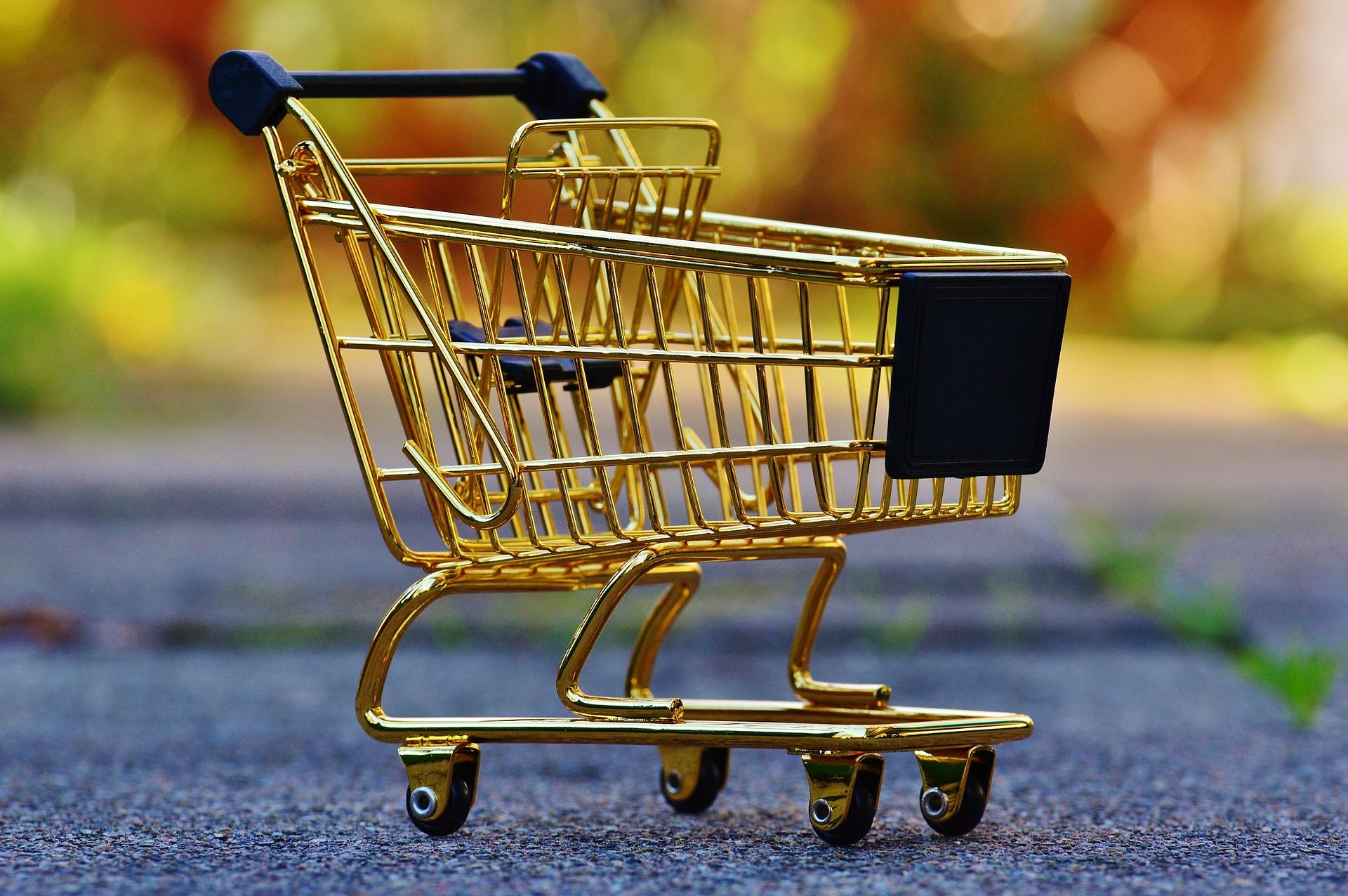
Here is a typical online shopping scenario: A customer browses through a website or online store, selects a few products, adds them to the cart then proceeds to checkout. The customer arrives at the checkout page but fails to complete the purchase for a range of reasons, and this is a common experience most online shoppers deal with.
The fact that customers abandon items in their shopping cart without completing the checkout process can cause a massive blow to your revenue generation efforts. However, this doesn't have to discourage you. There are still ways you can win back lost customers' hearts and have them complete their purchases.
In this article, you'll learn the best practices to apply when creating abandoned cart emails. You'll also learn about the best time to send an abandoned cart email.
Ready?
Let's dive in!
Table of Contents
- What Are Abandoned Cart Emails?
- Why Do People Abandon Their Shopping Carts?
- Best Practices For Creating Abandoned-Cart-Emails
- Examples Of Abandoned Cart Emails
- What Is The Best Time To Send Abandoned Cart Emails?
- Getting Started With Creating Abandoned Cart Emails
What Are Abandoned Cart Emails?
Abandoned cart emails are messages sent to customers who couldn't complete an online order on their shopping cart. Ideally, these emails are sent to customers who visit a website or online store and leave halfway through checkout. Abandoned carts are usually common amongst online shoppers.
Still, the good thing is that as a business owner, you have a better chance of winning back revenue that you would have otherwise lost with an abandoned cart email. When you send an abandoned cart email to your customer, you remind them of the products they left behind on the cart and encourage them to complete their purchase. But you don't simply send a cart recovery email telling your customer to complete their purchase.
It would be best to tailor your messages to incentivize them to take the required action without delay. But why do people abandon their shopping carts in the first place? The following section will provide an answer to this question.
Why Do People Abandon Their Shopping Carts?
As a business owner, there's no doubt that question would have crossed your mind. However, there are many reasons why people abandon online carts.
Some common reasons include:
- Some customers face website issues.
- Some customers are worried about the security of your platform, app or online store.
- Some people are just browsing through your website or online store.
- Some people are simply comparing prices,
- You have a complex checkout process.
- High shipping costs.
The truth is that there are some abandoned shopping carts that you can't do anything about. Some shoppers are just not ready to buy. But that doesn't mean that there aren't other shoppers you can drawback to complete their purchase.
With the right abandoned cart emails, you can convince your customers to return to what they left behind. So, what are the best strategies to apply when creating abandoned cart emails? The following section will highlight some of the best practices to help you create high-performing abandoned cart emails.
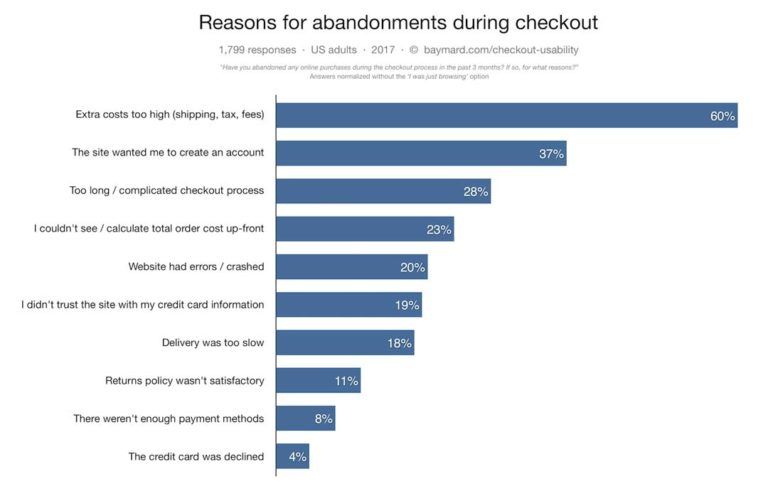
Best Practices For Abandoned Cart Emails
The best abandoned-cart emails are those that have a higher chance of convincing customers to complete their purchases. It all starts by applying the right strategies.
Here are eight best practices for creating abandoned cart emails.
1. Offer a discount: In some cases, customers may not complete their purchases because the final price of their order may end up exceeding their expectations. Often, additional shipping costs may discourage the customers from completing their purchases. Failed payments could also result from technical issues that arise with the payment method.
A good practice is to offer discounts to lost customers. But a word of caution - If you decide to provide a discount, you need to determine the type of discount that would be right for your business. Massive discounts may be good incentives to coax customers into completing a purchase - but they could also negatively affect your overall sales.
Create a discount code and leave it in the abandoned cart email when you decide on your discount offer.
2. Include a single clear call to action: The right call-to-action can make a big difference in your cart recovery emails—a clear CTA signals to customers the necessary action to take. However, it would be best to have a suitable CTA to drive users to action.
For example, which of these CTA texts do you think would be more compelling?
- Buy now.
- Pay for your order now.
- Complete your order.
Words like "buy" or "pay" tend to trigger the wrong kind of emotion and simply get the customer to do what they are not ready to do. On the other hand, a CTA text like "complete your order" suggests that the customer should finish the checkout process they started.
3. Reveal what they are missing out on: If you send an abandoned cart email without revealing the product your customer hasn't purchased, your customer may end up being confused about your message. If your emails leave them confused, they won't hesitate to add them to the spam folder.
In some cases, customers may not remember the products they added to the cart. Or they may even end up shopping on other sites. In this case, you need to remind them of the product they initially wanted to get by clearly displaying the items in your emails.
A customer would most likely return to your site when they remember how badly they needed your product in the first place.
4. Write compelling copy: As mentioned earlier, you need to remind customers of what they are missing by revealing the items in their shopping carts. However, you need a compelling copy to back up that strategy, and your customers would be more willing to engage with your emails with a convincing copy. Plus, it helps increase the chances of conversion.
Here are some tips for applying when creating a compelling copy:
- Create a sense of urgency in your emails: a sense of urgency is a common marketing tactic with good reason. Placing a sense of urgency can motivate customers to take action quickly. If people believe that a particular product would be available for a limited amount of time, they tend to grab that offer as fast as they can.
This is also known as FOMO (fear of missing out), and most people wouldn't want to miss out on a great offer. - Personalize your copy: a friendly personal tone in your email copy can make your customer feel appreciated and more willing to engage with your email. Studies have shown that personalized emails have a six times higher transactional rate than emails without a personalized tone. So, including your customer's name in your email and expressing your concern over their incomplete purchase can help get them back on your website.
5. Create visually appealing graphics: You may think graphics don't require additional effort. Afterall, a compelling copy and irresistible CTA should make your emails perform better. Think of graphics as an added booster to your email performance. Your customers usually notice the correct graphic elements, and it's essential for an excellent first impression.
Here are some tips for applying when designing an abandoned cart email.
- Choose stock images carefully: if you're to use stock images in your emails, you need to be careful with how you use them. Most people have become skilled at identifying generic images with no visual appeal. If you can, try to incorporate graphic elements that reflect your brand's image.
- Incorporate your brand color: using your brand color in your marketing campaign helps create a consistent and uniform layout.
6. Optimize your emails for mobile: This list for creating abandoned cart emails wouldn't be complete without emphasizing the need for optimizing your emails for mobile. Studies have revealed that 61% of emails are opened on mobile devices. So, don't hesitate to incorporate mobile optimization in your abandoned cart email. You'll not only be helping your business, but you'll also be helping your customer read your emails better.
7. Perform A/B split test on your abandoned-cart-emails: Sometimes guessing may not always lead to the best results when identifying what customers want to read in an email. Because you'll never know which email works best with your customers if you don't test them, with A/B testing, you can figure out what subject line, CTA, and email copy are more compelling. This way, you can deliver more relevant messages to your customers.
8. Create a well crafted and irresistible subject line: Customers often deal with an influx of messages in their inboxes. So, it would be best if you made your emails stand out. This starts by creating a compelling subject line. Your customers need to understand your subject line at first glance. So how do you create a subject line that quickly grabs your customers' attention?
Here is some relevant information you should include when creating your email subject line:
- Customer name: including a customer's name may help you get an increased open rate.
- Company name: your customers need to know who sends them a message.
- Simple text: no need to overcomplicate an email subject line that would only take a few seconds to read.
- Product name or details: you need to remind your customers what they left behind in their shopping cart.
Examples of abandoned cart emails
Now, you've learned some of the best practices you can apply when creating abandoned cart emails. In this section, you'll learn about some examples of abandoned cart emails that will serve as inspiration to help create yours.
1. Whisky loot
Whisky loot's subject line takes a unique angle to grab its audience's attention. The subject line "your cart is sobering up" is quite unusual and could get the reader curious, leading them to open your email. Hence, increasing your email open and click-through rates. The email begins with a question, followed by different ways a customer can use the product.
What this email does right:
- It has a strategic email copy and design: While the email copy may be long, whisky loot still ensures that it presents its email in an uncluttered and visually appealing way.
- It has a unique CTA: the CTA text "treat yourself" is presented in a non-salesy manner. Instead, it reminds the customer of using the product as an opportunity to have a good time.
- It has a FAQ section: it's always a good practice to answer customers' potential questions. Whisky loot acknowledges this tactic and does it well in its abandoned cart email.
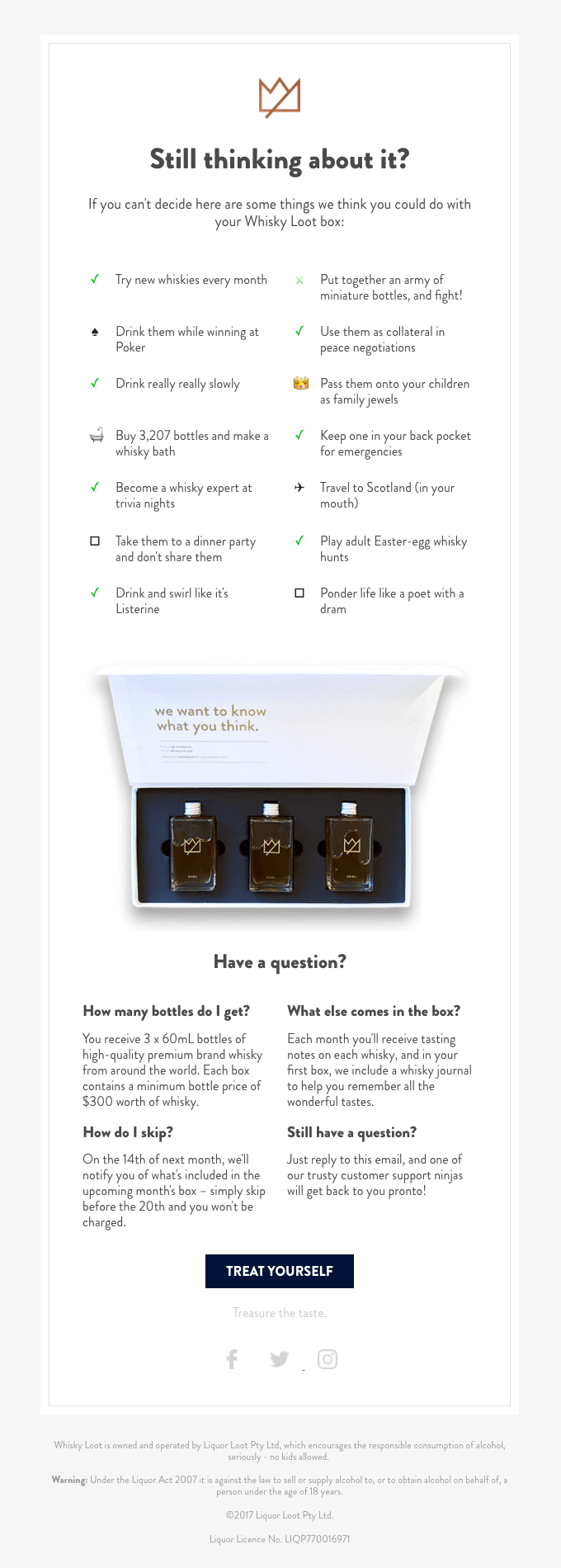
2. Dyson
In this abandoned cart email, Dyson applies several tactics well. Here are what this email does right:
- It has a sense of urgency: the email text "your basket for this promotion was saved, but the offer is only for a limited time" highlights a sense of urgency. This creates a fear of missing out, incentivizing the customer to take action as soon as possible.
- It features two CTA buttons: which makes it hard to miss. As customers scroll through, they can quickly complete their purchase at every touchpoint.
- It contains an image of the product: a picture of the product the customer left in the shopping cart is shown. This can remind the customer of missing out and motivate them to take action.
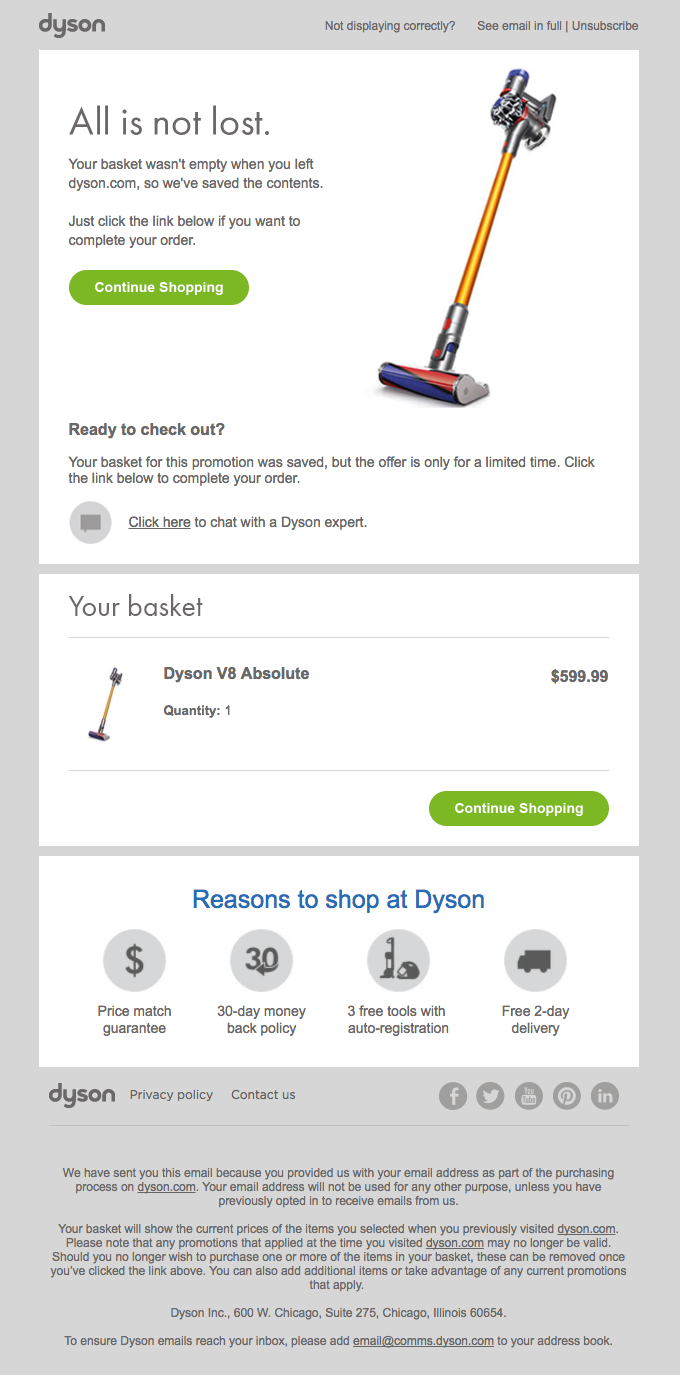
3. Timberland
This abandoned cart email begins with the subject line: "can't stop thinking about me?" This text can leave a customer curious enough to open your email.
Here are the things this email does right:
- It contains additional product recommendation: sometimes, customers have difficulty making up their minds on the product they want to purchase. One way to ease customers of this plight is by offering a little help on where to look. You can achieve this by adding additional product recommendations in your cart abandonment email.
Timberland does this well and ensures that its customers have more product options to explore. - They added a free delivery reminder: the email text "free delivery and returns on all orders" can remind the customer they don't have to worry about shipping fees.

Subject line: where did you go?
Dollar club does well to apply personalization in its marketing emails. The subject line is brief and creates a sense of curiosity, making the customer want to open the email and explore. The email also clearly applies bullet points to reveal why the company's razors are ideal.
Here are other things this email does right:
- It contains a clear product display: the product is displayed boldly to remind the customer of what they are missing out on.
- It contains a compelling copy: "No membership fees," "we'll refund your money" are statements that indicate to the customer that purchasing the product comes with low risk.
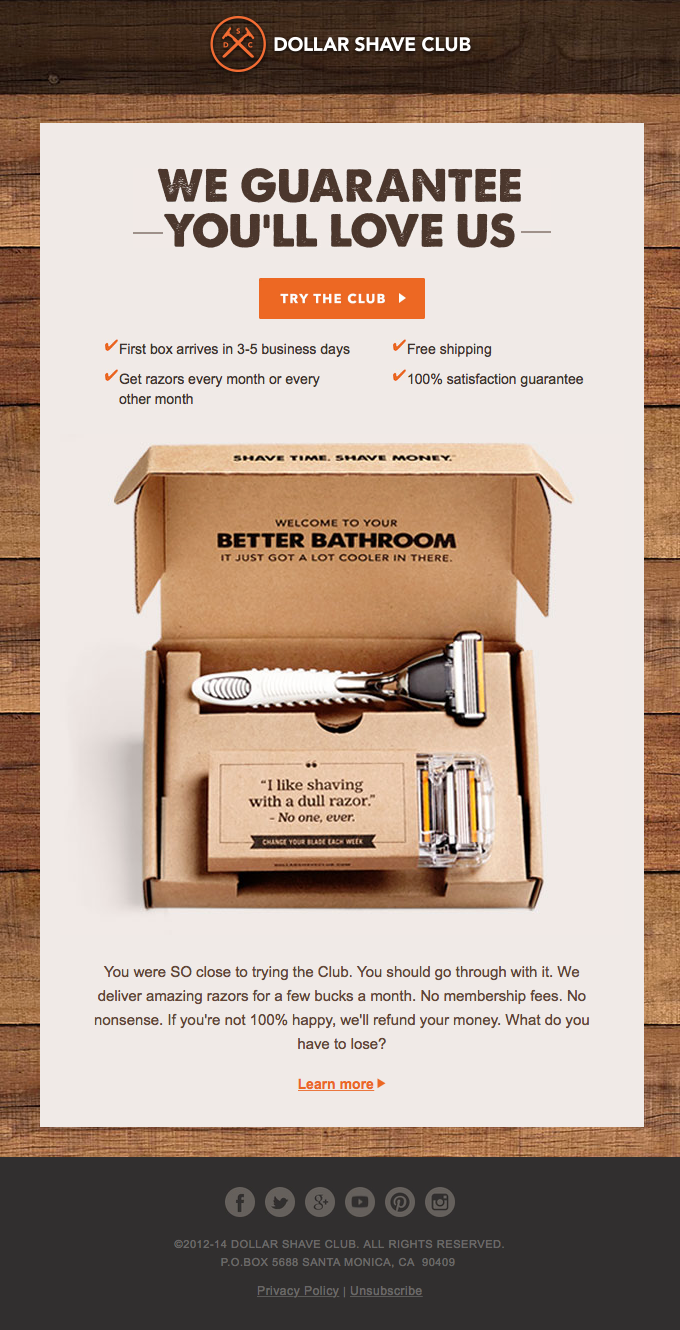
5. Casper
Casper's abandoned cart email incorporates clean, visually appealing imagery. The email begins with an unusual and unique text "come back to bed." This is followed by a reminder to nudge the customers back to complete their purchase.
Other things this email does right:
- It makes use of social proof: word-of-mouth and customer reviews are powerful marketing strategies that can attract the right kind of customers to your brand. Most people are usually inclined to buy from you when they see that other people benefit from your product.
- It includes additional link to read more reviews: Casper doesn't just include a single review in its email. The company also recognizes that some customers may still want to research before deciding on a product to buy. The email also includes a clear CTA button that entices the customer to continue shopping.
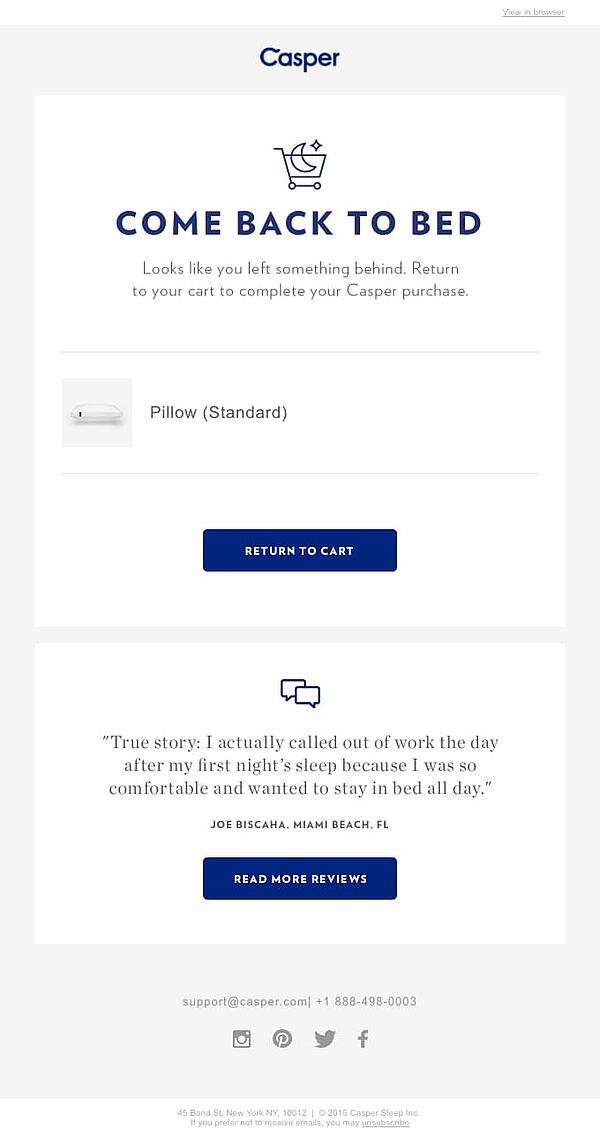
What Is The Best Time To Send Abandoned Cart Emails?
As the popular saying goes- "timing is everything." It also applies to when you send your abandoned cart emails. If you send your abandoned cart email too late or early, you could miss out on the opportunity to win your customer back forever.
Also, studies have revealed that customers conduct online research before making an online purchase. So, you need to plan your series of abandoned cart emails and send them an hour after the customer abandons the cart. Remember, don't wait later than 24 hours before you send your emails, so your audience receives your email when the transaction is still fresh in memory.
With Engage's Automation feature, you can create an Abandoned Cart Email sequence for your business and send these emails at the right time to your customers.
Step One: Create an automation trigger on Engage. For our example, we are tracking customers who have added product to cart.
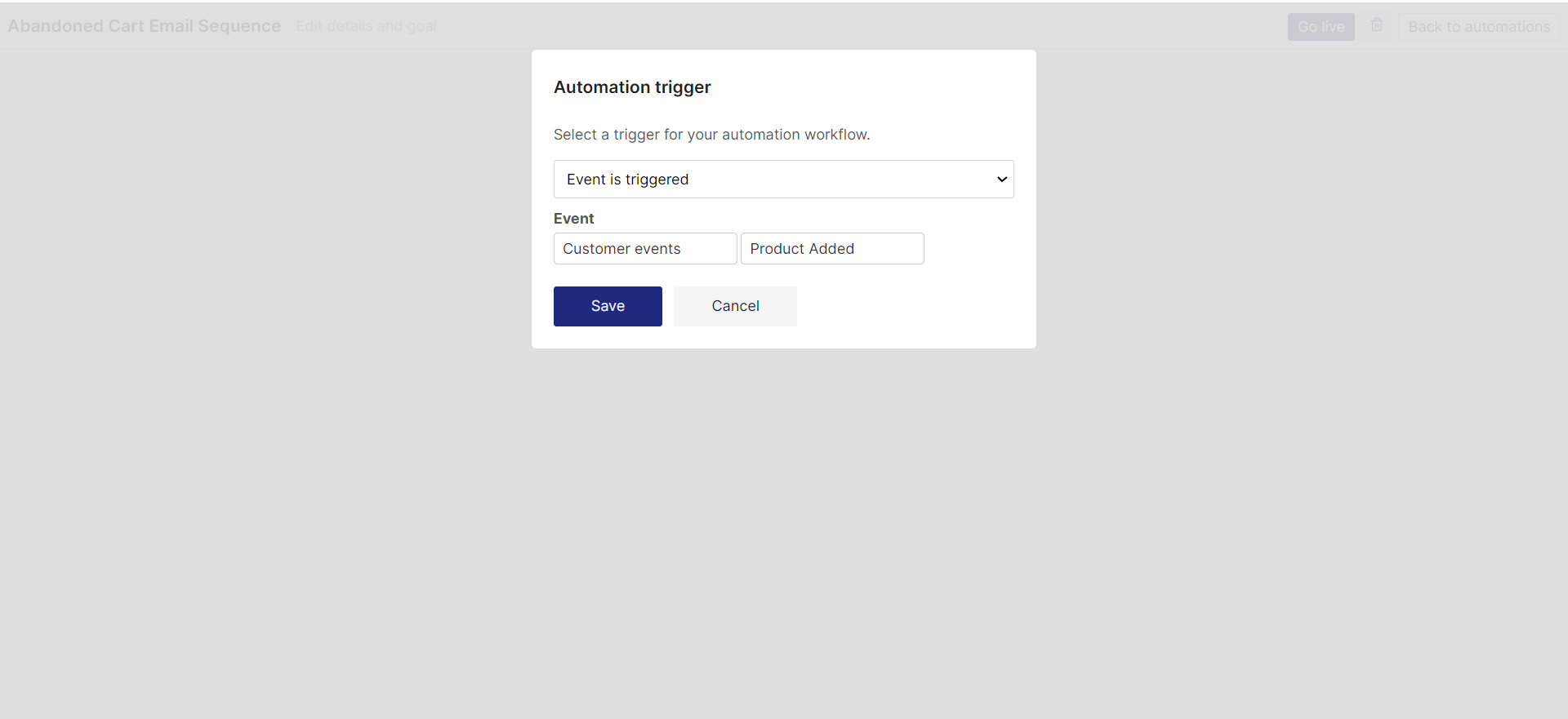
Step Two: Launch your abandoned cart email sequence on Engage. For our example, after we have created an abandoned cart email sequence, we can launch the automation and make it go live.
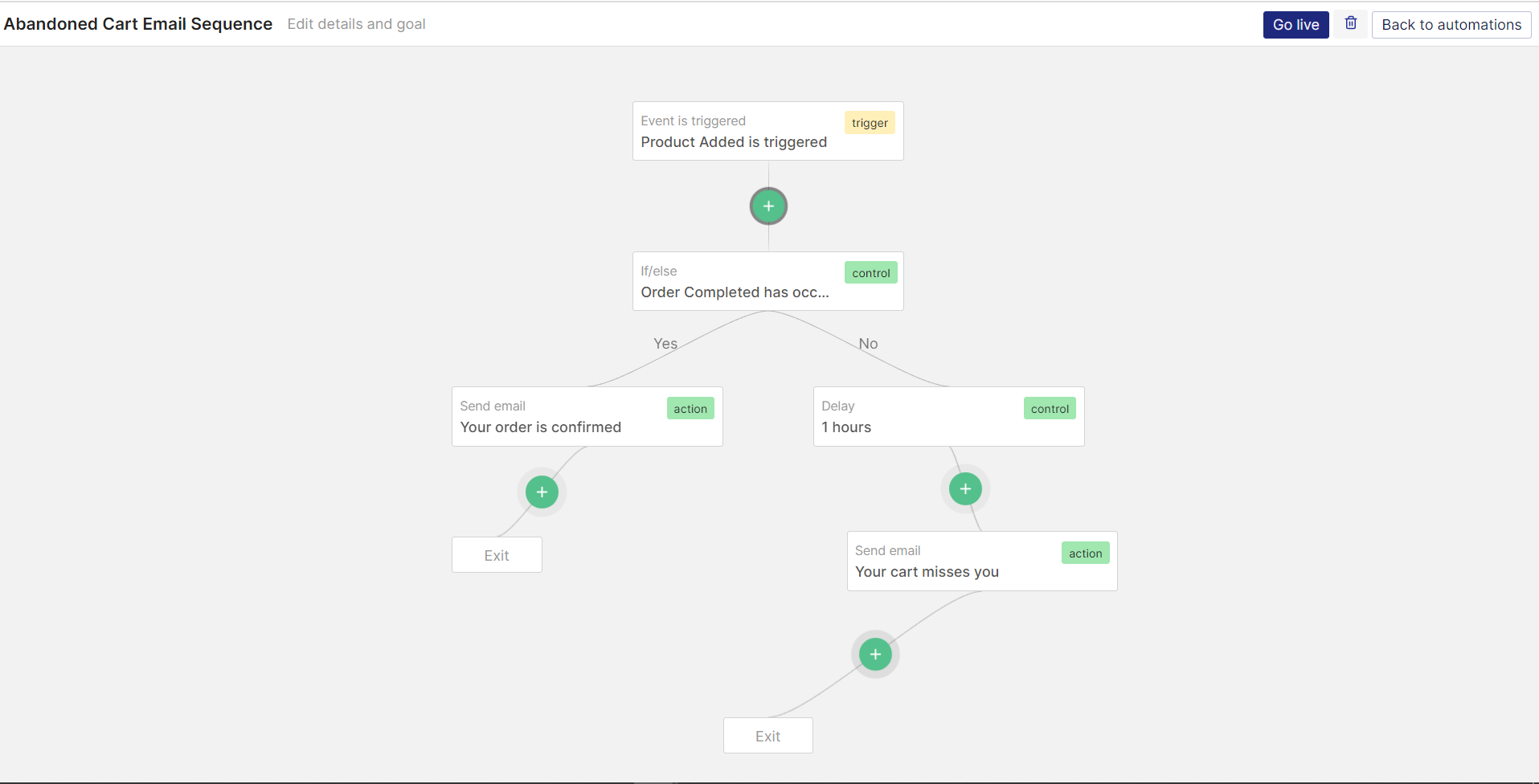
Getting Started With Creating Abandoned Cart Emails
You need to create the best performing abandoned cart emails to win back your customers. With Engage, you can track cart events like "Product added to cart" and use this to create email automations to automatically send your cart emails. If you use Stripe checkout, Engage supports Abandoned cart recovery for Stripe checkout and even provides an Abandoned cart recovery automation template you can use.
